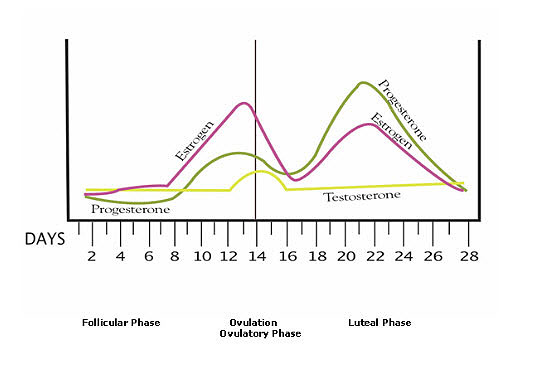When is the best time to test for hormone imbalance in women?

Table of Contents
Timing for Female Hormone Testing
Throughout our life, male or female, many of us reach a point where things may not feel quite right. Our energy levels may be low; our desire for sexual activity is not what it used to be if it exists at all. We may be experiencing unexplained weight gain or muscle loss, not to mention issues with fertility. It is for these reasons; many men and women will seek out treatment options. Such options sought out by both sexes have increasingly been hormone treatment plans, which almost always begin with blood testing. This process is relatively more straightforward for most men, but female hormone testing is slightly more complicated. Timing for the female hormone blood panels is an essential factor that must be taken into consideration.
Female Hormone Testing Through Menstrual Cycle
When determining hormone levels within the body, a premenopausal woman requires blood tests that are timed for the most accurate results. You will find some labs, and physicians will offer saliva-based tests, which may not provide accurate results, but blood testing will often be the way to go for a fuller measure of various markers in the body.
While the various tests are essential, blood testing itself must be coupled with appropriate timing. For example, for the adult male, generally, the best time to have blood drawn for testing is the first thing in the morning on an empty stomach. Some women may follow a similar approach, but for the female, this is far from optimal. Hormone testing for premenopausal women, our focus here today, is best timed around the woman’s cycle. Fasting may be necessary as it is with men, but the female hormone blood test's timing needs further consideration.
Women's Hormone Blood Testing Mistakes
Failure to time a blood test around a woman’s cycle may render inaccurate hormone lab test results. One may find their hormone levels similar to a postmenopausal female even if still well within the premenopausal stage of life if the timing is off. For a healthy adult female with regular menstrual cycles, estrogen and progesterone blood test levels will be extremely low at the beginning of the follicular phase of one’s cycle. These hormones will often mimic that of a menopausal female despite functioning ovaries. Any testing done during this period of a woman’s cycle is useless. Although both men and women experience fluctuations in hormone levels throughout the day, week, and even months, more significant changes usually exist within a woman’s monthly cycle.
The Best Time for Female Hormone Blood Testing
As menstrual cycle timing is crucial related to female hormone blood testing, most premenopausal women will find labs to be at their most accurate state at days 19-21 of their monthly cycle. This period is when they are at their peak production of progesterone. As alluded to before, progesterone will be lower during other points of the cycle to even seemingly nonexistent during the follicular stage.

As many women supplement with progesterone, often for fertility purposes, one might ask how this would impact their choice in timing? If a woman is supplementing with medical progesterone, as it is usually only taken during the luteal phase of her cycle, which is when progesterone is sometimes only taken for fertility purposes; it is important to have blood work done at this point to view accurate results. As is with the woman who is not taking progesterone, we are merely attempting to test our hormone levels when progesterone is at its peak.
It is important to note that some doctors prescribe testosterone for hormonal imbalances in women. However, suppose a low dose of progesterone does not accompany this exogenous testosterone. In that case, the testosterone treatment may negate the benefits of HRT since a therapeutic-created form of estrogen dominance will affect the quality of life. The introduction of a low dose of progesterone will help normalize the whole hormone gambit within the woman’s body, thereby producing measurable results that can help her reach optimal health should treatments need adjustment.
If you still have a menstrual cycle, the time of the month for estradiol and progesterone test is essential. Wrong timing will often render your lab result useless because, at certain times of the month, healthy women with normal and suboptimal hormone profile will have similar numbers to menopausal/peri-menopausal women. During the early follicular phase, estrogen and progesterone are naturally very low and in the menopausal range, even if you are a healthy 28-year-old with fully functioning ovaries and fertility. So, testing on the wrong days does not give you any useful data on your ovarian function. For women with 28-day cycles that ovulate on day 14, the best day to evaluate progesterone blood test levels is at its highest, seven days after ovulation.
Female Hormone Testing Data
A study published in 2006 reviewed the issue of timing of premenopausal hormone blood testing. It was a three-year study that included regular blood testing of 113 premenopausal women. The study performed estrogen and progesterone blood tests in both the luteal phase and the women’s cycles' follicular phase.
Data from the study showed that the differences between tests performed at the luteal and follicular phases were significant. Levels of free estradiol were the only marker of relative statistical insignificance. Estrogens and androgens, among other items, were statistically opposed between the two periods of testing, reinforcing the need for women to plan their hormone blood testing accordingly with their monthly cycle. While many women do not track their cycle, if blood testing is necessary and you are attempting to get to the bottom of an issue, tracking it is essential to make sense of female hormones' lab test results.
If you find hormone testing is something you would like to do, a great place to start is with Discounted Labs’ Women’s Hormone Tests
References
Stacey A. Missmer, Donna Spiegelman, Elizabeth R. Bertone-Johnson, Robert L. Barbieri, Michael N. Pollak and Susan E. Hankinson. “Reproducibility of Plasma Steroid Hormones, Prolactin, and Insulin-like Growth Factor Levels among Premenopausal Women over a 2- to 3-Year Period.” Cancer Epidemiol Biomarkers Prev. 2006 May;15(5):972-8.
Prior JC (2020). "Women's reproductive system as balanced estradiol and progesterone actions—A revolutionary, paradigm-shifting concept in women's health". Drug Discovery Today: Disease Models. 32, Part B: 31–40.





